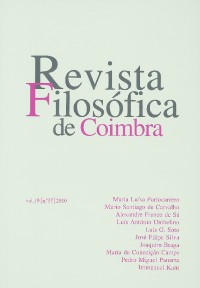Please use this identifier to cite or link to this item:
https://hdl.handle.net/10316.2/33339| Title: | Formas imagéticas e formas discursivas | Authors: | Braga, Joaquim | Keywords: | Pictorial forms;Discursive forms;Articulation;Materiality;Configuration;Formas imagéticas;Formas discursivas;Articulação;Materialidade;Configuração | Issue Date: | 2010 | Publisher: | Faculdade de Letras da Universidade de Coimbra, Instituto de Estudos Filosóficos | Abstract: | A redução do cultural ao visual parece hoje sustentar uma crítica
negativa da imagem. Crítica essa que, ancorada na ideia de uma pretensa
impotência da palavra perante a ascensão das formas imagéticas, tende a
assumir, muitas das vezes, um carácter iconofóbico. Dois dos fundamentos que
servem comummente para justificar tal primado medial das formas imagéticas
sobre as formas discursivas podem ser enumerados do seguinte modo: (1) a
medialidade imagética é marcada por um perfil transcultural invariável, não
dependendo, por isso, da configuração cultural dos actos perceptivos; (2) as
estruturas visuais que tornam possível essa invariabilidade possuem uma
autonomia em relação às estruturas linguísticas das formas discursivas. A
reflexão que aqui se apresenta tem como objectivo principal questionar o
conteúdo destes dois fundamentos, apontando, por outro lado, para modelos de
interpretação alternativos capazes de dar resposta à relação cultural entre formas
imagéticas e formas discursivas. The interpretation of culture only by visual forms seems to lead, today, to a negative evaluation of images. This negative evaluation, based on words’ loss of power in comparison to ascendancy of pictorial forms, usually undertakes an iconophobic character. Two of the reasons that commonly justify the medial primacy of pictorial over discursive forms can be expressed by: (1) visual mediality is characterised by an unchangeable transcultural dimension and is independent of cultural influence on human perception; (2) visual structures that enable the unchangeable transcultural dimension of pictures are self-governed in relation to linguistic structures of discursive forms. The major aim of this paper is to enquire the content of the arguments described above. Another aim is to purpose alternative arguments that are able to connect pictorial to discursive forms, by a cultural point of view. |
URI: | https://hdl.handle.net/10316.2/33339 | ISSN: | 0872-0851 | DOI: | 10.14195/0872-0851_37_7 |
| Appears in Collections: | Revista Filosófica de Coimbra |
Files in This Item:
| File | Description | Size | Format | |
|---|---|---|---|---|
| rfc37_artigo8.pdf | 4.22 MB | Adobe PDF |  |
Items in DSpace are protected by copyright, with all rights reserved, unless otherwise indicated.
